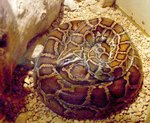Caring for large snakes
Reticulated pythons, burmese pythons, boas, and anacondas
By Christina Obrecht, June 13, 2008 9:00 PM PSTStarting with the burms;
You must think wisely when you are considering owning a large snake. Burms can grow to be over 22 feet, weigh well over 250 pounds, and live between 25-30 years. While you may think it is cool to have a huge snake, think about the responsibility. Burmese pythons are native to Southeast Asia, including Burma, Thailand, Vietnam, southern China, and Indonesia. The native population is considered to be "treatened". They are rainforest dwellers and are very good swimmers. They spend most of their morning hours soaking up the sun getting warm enough to go hunting for prey later on in the day.
Sure you may think it's a piece of cake while they are small. Hatchlings require at least a 55 gallon tank already - did you know that? Once they are full grown, which can take only a few years (3-5), they will require a much larger enclosure; even a bedroom! You will have to build your on cage as your burm gets big enough; such as 10 feet....
As your burm grows, you will also not only need to keep enlarging the enclosure, but its hide box and water bowl as well. They DO require a hide box. You can use cardboard boxes, well cleaned garbage cans, etc. As for a water bowl, you will have to use your imagination. The bathtub will become a nesecity when it outgrows its waterbowl. They will need to soak in warm water, esp when it is time to shed.
When you get your burm, use paper towels or unprinted newsprint, it will be easier to clean, and notice if it is defecating properly. after your burm has settles in, you can change its beding to shredded cypress, fir bark, astroturf, or linoleum. Do not use orchid bark, pine, cedar, or redwood shavings, as they can get lodged in their mouth. There is no specific lighting requirements for pythons and boas. You can use incandecent light bulbs (red, and or blue for night); just make sure there is a screen cover over the bulb, as burms easily burn.... Keep an ambient air temperature of 85-88 degrees, a basking spot of 90 degrees, and no lower than 78-80 during the night.
Keep in mind these giants will require a lot of food as well. Not so much that they become obese! They do not require a large rat every other day! If you cannot afford or handle feeding rats, rabbits, or chickens to your snake, then do not get one! Always make sure to get your food from a reputable breeder or pet shop. Never feed your snake wild caught food!! They may carry diseases. The python and boa family are suceptible to Inclusion Body Disease (IBD); this is a deadly disease for the pythons especially. Keep in mind this is a virus, therefore it is an airbourne disease. Always quarentine your new snake for a good month or two. As this disease may not show up for a year.... Some of the signs to look for are; loss of appetite, regurgitating their food, mouth rot, respiratory infection, contorted body positions, and stagarizing. Always keep this in mind while looking to buy a snake as well. Check the snake before you buy it; and always buy a captive bred snake - not wild caught!
If you are looking to breed this snake, while it is not exactly suggested, they breed in early spring; and will lay eggs in March or April. The female will lay 12-36 eggs in a clutch. Just remember, some people may buy them when they are small, but quickly want to get rid of them when they get too big for them.
When you purchase your burm, or any large snake, it is important to interact with them constantly. You should create a good relationship with your snake so that you are both comfortable with each other. Do not force it to do anything it doesn't want to do. Remember, while it is your pet, they can always turn! Yes, they do have the capability to constrict a human when it is an adult; that is a chance you must live with, if you decide to keep one. Never let your snake slither around the house if you have dogs or cats... with you, unless you close them in another room. Remember snakes are clever and can find a way around the house. Always supervise your snake if it has free roam of your house!
Good luck on your adventure with your burm!
